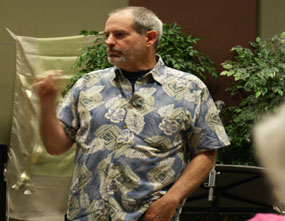We’re in the process here, looking at all 5 steps over the next couple of weeks. Step 1 was an overview, step 2, today, is about fundamentals, step 3 will be about tactics, step 4 will be about monthly plans, and step 5 will be about a review cycle.
Here’s the premise: In any musical ensemble, the real work is done during rehearsal. How you approach rehearsal time, whether you are the director, or a member of the ensemble, will have a lot to do with how the eventual music making turns out. It’s not practice — practice is what you do to get ready to rehearse. Rehearsals should be specifically about getting ready do the music for real.
Last time, we talked a bit about the great football player Jerry Rice, who was inducted into the pro football hall of fame last weekend, and his legendary preparation habits. Rice says that he worked on his fundamentals every day…never taking a vacation during his first 13 years in the league. While that might seem extreme, it shows his level of dedication to getting it right.
The best ensemble directors go into a rehearsal with a plan that results from and communicates their dedication to the ensemble getting it right. Part of that rehearsal plan must include work on fundamentals.
Ideally the ensemble members will, like Jerry Rice, practice their fundamentals every day outside of rehearsal. But, for amateur groups, it is unlikely that any of the members will have Rice’s extreme approach. The director’s rehearsal task, especially for an amateur group, is twofold, then: To have short and long term goals, and either work on the fundamentals necessary to achieve those goals, or motivate the ensemble members to do so on their own.
To address the fundamentals set up a system (a spreadsheet will work nicely for this) to articulate the following:
Goals for the year
This might be: the ensemble will achieve certain benchmarks in being in tune over at least a page of music; and/or they will be able to consistently produce the difference between staccato and legato phrasing over 8 measures or more; and/or they will be able to communicate the text in a dramatic manner in the character of the emotional subtext of the music for at least one piece per performance. You’ll notice that the goals are quantifiable: they are more specific than “should be in tune.”
Goals for the Individual
Once a director knows the goals for the year, it is easy to communicate to the ensemble members what specific fundamental exercises they can work on at home to achieve those goals. Additionally, it allows a director to consistently work on those goals in every rehearsal, both by teaching the fundamentals through group exercises, and by selecting music that will present opportunities to work on the problems that the goals outline. Remember that rehearsals are to prepare for the performance, not just practice because a rehearsal is scheduled. As a director, there is a great advantage to being open about the specific long term goals, and explaining how a particular rehearsal will have short term goals designed to meet the long term goals. Optimally, rehearsals create the same environment as concerts, except that they take place without an audience.
Next time, we’ll discuss specific tactics to accomplish short and long term goals, followed by guidelines for setting up those long term goals, and, finally, we’ll look at how to systematically review what is working and what needs to be fixed.
Check back on Friday, August 13, for the next installment. In the meantime, if you have a comment, please let me know what you think below. If you have specific things you want me to cover, I’ll do my best to include them.
…
You can follow me on twitter here
Get my EBook The Choir in Modern Worship here
Join me on facebook here












You must log in to post a comment.